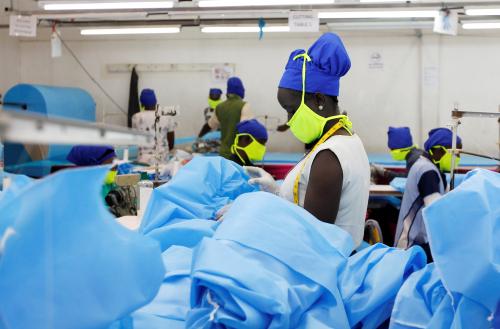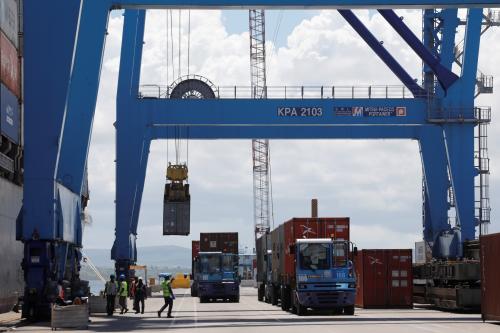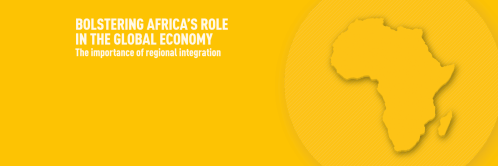Beyond the direct dramatic human consequences, the COVID-19 crisis will have a long-term, strong, adverse impact on Africa as it hits its economies. Primarily, evaluations estimate a contraction of the GDP for the major economies of the continent. The variations in GDP from 2019 to 2020 are huge: Algeria at -5.9 percentage points; Egypt, -3.6; Morocco, -5.9; Nigeria, -5.6; South Africa, -6. Indeed, given the oil and commodities shocks, decreases in labor productivity and total factor productivity, and increased costs of international trade that will particularly hurt smaller economies, Africa is acutely exposed.
Just how hard will COVID-19 hit African economies if the crisis worsens?
The last World Economic Outlook from the International Monetary Fund forecasts a -3 percent contraction in world GDP in 2020, and a -1.6 percent contraction for sub-Saharan Africa for the same period—a 4.7 percentage-point reduction in sub-Saharan Africa’s growth compared to the 3.1 percent growth estimate of 2019. North African economies will experience similar dramatic contractions. In recent analysis, we explore what could happen if the situation continues to deteriorate. To do so, we estimate potential hits to African economies under two scenarios: 1) a case where a global recession causes a 4 percent drop in global GDP and 2) a more severe scenario of an 8 percent drop in world GDP in the case that the pandemic persists across the entire year. Given the specificity of many African economies in relation with their size (small economies), exposure to external shocks (commodities, remittances, tourism, etc.), and reduced fiscal and monetary policy space, an exacerbated world recession would not be translated linearly to these economies but threatens to spread more severely.
Overall, we find that, if the situation were to deteriorate more than expected, with global growth at -4 percent, Africa would experience a decrease in GDP of 7.9 percentage points (Figure 1). In case of the second scenario, we estimate that loss to be 12.31 percentage points. The fall in the world GDP will no doubt lead to a severe fall in the exports demand for African products due to the fall in the global demand. Given the specificities of African economies, the negative impact would be more than proportional. In addition, the impacts will be higher the more trade between Africa and the rest of the world is important. The AfCFTA will thus have the advantage of boosting intra-African trade, contributing to mitigate the rapid decline in African GDP. Notably, we estimate that Eastern and Western Africa will be hardest hit, with decreases in GDP of -9.76 and -8.87 percentage points, respectively, in the first case, and -14.55 and -13.51 percentage points in the second case. These two subregions will likely experience the stronger trade shock due to their dependence not only on minerals, gas, and oil exports, but also on the production and export of electronics.
How might an implemented African Continental Free Trade Area mitigate a worse economic impact due to COVID-19?
COVID-19 is, at the same time, both a supply shock and demand shock. Given the magnitude of both shocks, the COVID-19 crisis may lead to an significant reorganization of global value chains (GVCs), perhaps leading to a higher reliance on regional value chains (RVCs). Given the potential for the African Continental Free Trade Area (AfCFTA) to serve as a real economic engine at the continental level, policymakers must maintain the momentum toward its implementation.
Indeed, a successfully implemented AfCFTA will empower the region to more successfully navigate the hit the region’s economies will take (and are already taking) (Figure 2). In the case of immediate implementation by all African countries—so if 90 percent of intra-African tariffs are removed according to the AfCFTA modalities—the drop in Africa’s GDP would be -5.2 instead of -7.9 percentage points, in the case of a 4 percent drop in world GDP (“COVID1” versus “AfCFTA” in Figure 2). The decreasing world demand is then partially compensated by new export possibilities across the continent for African economies, due to the removal of intra-African trade tariffs. In terms of immediate priorities, this acceleration of tariff dismantlement could be supported by customs green lanes, in particular for medical, pharmaceutical, and food products.
Considering the disruption of COVID-19 on value chains (particularly on trade operations) as well as on expected trade restrictions measures, we anticipate a short-term rise in trade costs. To examine this impact, we consider a 5 percent increase in trade costs for all countries across the world and find that this increase will soften the AfCFTA’s ability to mitigate the crisis by a full percentage point of GDP in the case of the whole of Africa (Figure 2, AfCFTA HC). (Note that our assumption is based on the already existing increases. To illustrate this dynamic, WTO compiled a provisional list of measures already in place in 139 countries for some goods. Increase in trade cost could come from services trade costs, specialized equipment, and/or border controls as illustrated by Methodology for the WTO Trade forecast of April 8 2020.)
To counter this softening, African countries might consider, in addition to the AfCFTA, supporting immediate trade facilitation (TF) measures—what we call “quick wins”—such as dematerialization and continental customs clearance system, the rapid implementation of the WTO Trade Facilitation agreement, and more fundamentally address facilitation along the entire length of corridors across the continent, within the AfCFTA framework. These moves would counterbalance the rising trade costs, improve the capacity of African countries to better benefit from the reorganization of GVCs, and strengthen RVCs—thus mitigating economic and social impact of the crisis through new business opportunities, counterbalancing the deflating pressures on production and salaries.
This scenario (AfCFTA HC and TF) includes a 10 percent reduction in trade costs among African countries, while the 5 percent increase is still present all over the world. The impact on the mitigation’s potential of the AfCFTA is significant, as the change in GDP induced by COVID-19 is reduced from -7.9 to -4.3 percentage points.
Trade facilitation measures can be a lifesaver for food and nutrition security
Our results indicate that at the sectoral level, trade facilitation reforms have a strong impact on intra-African trade in agriculture, food, and petroleum and chemicals—sectors linked to the continent’s ambitious food security policy. Without implementation of such measures, the disruption of supply chains—accompanied by observed trade restrictions—could seriously affect African food security and sovereignty, particularly in a time of a plague of locusts in East Africa and continuous drought over the last three years in the southern part of the continent.
Recommendations
With these potential impacts in mind, there are a number of policy measures that policymakers should consider as Africa faces COVID-19 head-on:
Given that the AfCFTA could significantly mitigate the economic consequences of COVID-19—particularly if the situation worsens—leaders should speed up its implementation instead of delaying it; they should also involve all economic operators in the identification of priorities for trade facilitation reforms and enablers for a rapid and ambitious implementation of the agreement. At the sectoral level, fast-tracking imports and exports by creating green lanes for medical, pharmaceutical, and food industry is a priority, as well as strategizing an approach to build back better through strong emphasis on climate-resilient and green regional value chains.
Technically, the agreement establishing the AfCFTA entered into force on May 30, 2019 for the 24 countries that had deposited their instruments of ratification. Notably though, the “start trading” on July 1, 2020 has been delayed due to the pandemic. Given that the AfCFTA can serve as a significant policy lever mitigating COVID-19’s consequences, it is crucial to get the process back on track. Online negotiations and a virtual AfCFTA summit could be a solution if the challenges and risks related to the capacities of some member states are fully considered. In the meantime, initial AfCFTA trade could start with green lanes on critical goods needed to fight the pandemic. To ensure that the AfCFTA can be an effective tool for fighting the pandemic, the African Union could encourage mainstreaming COVID-19 strategies into national AfCFTA plans.
The complex consequences of the COVID-19 pandemic, coupled with other crises already impacting Africa (security in the Sahel, drought, locust plague), bring the risk of a mass poverty spiral at a scale the continent has not faced in its recent history. UNECA has shown that between 5 million and 29 million people could be pushed into extreme poverty as a result of the pandemic. Since the AfCFTA can provide the vehicle for going to scale through a pooled African market, policymakers may consider ambitiously pursuing specific trade facilitation measures and resilient infrastructures—the “quick wins” we discuss above—in their current implementation of the agreement and when engaging in Phase II of the AfCFTA negotiations.
Note: This blog represents the opinions of the authors only. It is not meant to represent the official position or opinions of UNECA/UNIDEP or its members or any additional and respective institutional affiliations of the authors, nor of the Brookings Africa Growth Initiative. For the full analysis, see “The African Continental Free Trade Area in a Covid-19 time: macroeconomic and sectoral impacts.”
The Brookings Institution is committed to quality, independence, and impact.
We are supported by a diverse array of funders. In line with our values and policies, each Brookings publication represents the sole views of its author(s).












Commentary
The African Continental Free Trade Area and measures to facilitate trade could significantly mitigate COVID-19’s economic impact in Africa
May 22, 2020